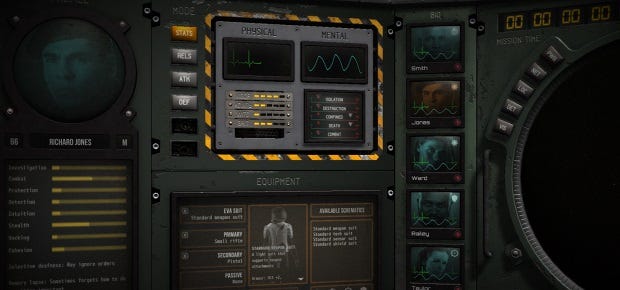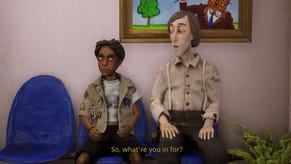Wot I Think: Deadnaut
Derelict?
There was one very good Alien game this year and in Deadnaut, we almost had another. While Isolation acts as a straight sequel, pitting a Ripley against a familiar creature in a familiar place, Deadnaut is about the horror of the unknown. With no license and no restraints, it is free to populate its derelict vessels with randomised beasties, ranging from the possessed corpses of former crew members (themselves alien) to skittering tentacled terrors. And ghosts. Alien ghosts on dead spaceships.
On one level, yes, Deadnaut captures the feeling of Dallas, Kane and Lambert exploring the Derelict on LV-426. You're cocooned somewhere safe, relaying orders and watching their life signs tremble and shift toward flatline. On another level, Deadnaut is Viscera Cleanup Detail played straight. It's a game about the aftermath of terrible events, but here the aftermath has teeth and claws of its own.
I think it's fair to describe it as a survival horror game, although certainly not a conventional one. Rather than dropping the player in the thick of the horror, Deadnaut leaves them in the safety of a command capsule, relaying orders to a boarding party who are exploring a haunted wreck. Their mission may be one of salvage or they may have what seems to be a higher purpose, destroying artifacts that produce a malign influence on living things. Sometimes these ships seem to have dropped straight out of the Warp, bringing an unhealthy dose of Chaos into the world.
Deadnaut doesn't throw aliens in your first-person face but it is a first-person game in the sense that you see what your character sees, stationary in a command module, with a data log off-screen to the right, brought into view by turning your head, and the details of your boarding party to the left. On the central screen, which bears an eerie resemblance to a ship's porthole making events seem less than a window's thickness away, a map of the ship you're exploring is revealed, room by room.
Before boarding each ship, you'll receive some advance warning as to what might be waiting on board. A scan tells you how many lifeforms should be expected, and you'll receive data regarding the type of ship (medical, military etc) you're entering, the distribution of energy and the forms of security you're likely to be facing. In an ideal world, all of this information would allow you to plan ahead, adjusting equipment loadouts and crew.
Deadnaut does not take place in an ideal world. Campaigns are short, running across four ships, which makes the game brilliant for short bursts of play and also fits the theme perfectly. There's no way your crew would survive more than four drops - as it is, you're likely to be working with degenerating clones based on the DNA of those who do die during a mission. But the problem with the brevity of the campaigns is that it leaves you victim to chance.
To improve your chances between one mission and the next, you can purchase new equipment using a form of currency that is part reflection of the information you bring back from a ship and part a representation of experience earned by completing objectives. Blueprints found during missions provide access to more specialised or higher tier equipment but because of the randomised layout and contents of each ship, you're not guaranteed any particularly worthwhile bounty. That means there's not always a great deal of space for tactical preparations - you go in with what you've got and do your best to survive.
That said, Deadnaut isn't anywhere near as punishing as first impressions might suggest. Orders are given to units individually or as a group and mostly involve moving from room to room or interacting with hotspots. Those hotspots often indicate an alien corpse, which might contain a log giving some information about the build-up to whatever disaster left everyone in bits. They're almost uniformly brilliant, toying with your knowledge of scifi history - there's talk of strange sounds, of suspected bureaucratic meddling, of the crew behaving erratically since picking up a mysterious load of cargo.
Sometimes you realise you're in the middle of a Dead Space scenario, sometimes it's Event Horizon. All of the information about the threats on a ship and its previous crew is transmitted in text form. You can see threats moving on the map in abstract form - blobs fighting blobs - but every time your deadnauts encounter a specific type of entity, they'll send back information about it. Through stats and descriptions you can build an image of each new threat and learn how best to counter it. If it has a habit of dragging deadnauts to their doom, separating them from their teammates, throwing up defensive fields might help to block its attacks. If it is slow but powerful, it might be possible to use one deadnaut as bait, leading the creature into crossfire.
Security is slightly more predictable, mostly taking the form of sentry turrets and the slightly more enigmatic 'Watchers'. Turrets shoot deadnauts. Watchers attempt to reset the ship to its initial status, locking doors that you've opened and potentially separating the team. To override them, firewalls can be set up by hacking computers.
There are power systems to play with as well, which seem to reroute energy, but even after playing for a few hours I'm not always entirely sure if I'm doing the right thing by powering up a specific room at the expense of another. I think I'm doing what's best for my poor little squad but, then, they do keep dying. But I guess that's kind of expected, given that they're called deadnauts and I keep sending them onto derelict ships that have quite possibly just returned from a vacation in a nearby hell dimension.
The confusion that surrounds certain features is part of Deadnaut's lasting charm as well as its great flaw. When I succeed, I often feel that the random number generator threw an easy ship at me. I rarely get the buzz that comes from hard-earned victory. But if everything was cleanly and clearly explained, the atmosphere would be sucked out the game like it so often is out of a ship that takes too much internal damage during a mission.
The presentation is fantastic and relies, in part, on a hazy understanding of what is actually being portrayed. Occasionally a scene crystallises brilliantly, providing a snapshot that burns into memory. During one mission, the first living thing I encountered was in a medical facility, crawling by a surgical bed, slow and apparently harmless. It was a startling moment, conjuring up images of things that should be dead, writhing and choking, forgotten for centuries in the dark.
A burst of static interrupted the visual feed for a few seconds and I feared the worst, expecting the thing to have lunged, suddenly a monster rather than a misery, but it had barely moved. My deadnauts riddled it with bullets and muttered grimly to one another.
Deadnaut is a deceptively simple game. Move from room to room, use the right skill at the right time, and you'll go far. There are layers of apparent complexity in the form of personalities for the crew and oodles of flavour text describing the origins of a ship, but the former traits tend to cause minor interruptions to missions rather than adding to any roleplaying aspect of the game. The characters need more room to breathe but the game keeps asphyxiating them. The flavour text is wonderful though - Deadnaut creates wonderful procedural and emergent fictions before and during every mission, and I wish I could recommend it on that strength alone.
There's not quite enough to it though. For all the possible variety in the types of creature and ship, missions tend to play out very much alike from one to the next. It's a splendid curiosity but I doubt I'll be playing it by the time 2015 rolls around in a couple of weeks. It has made me far more interested in Screwfly though - with this and Zafehouse Diaries, they've shown an approach to tactical survival storytelling that isn't quite like anything else. There's plenty of evidence in both games to suggest they might be responsible for a future classic at some point down the line.













